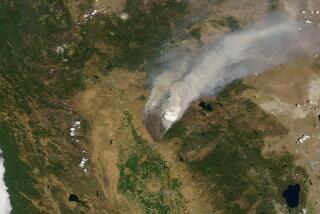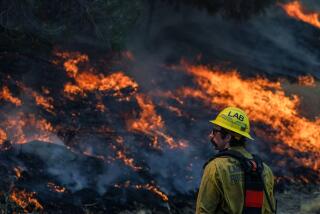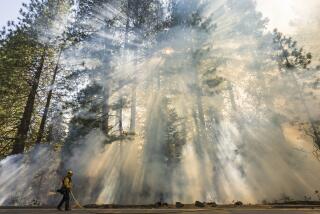Yosemite fire: Battle continues through Labor Day weekend
GROVELAND, Calif. — The Rim fire has burned into Yosemite National Park and into the record books, consuming 222,777-acres. It is now 40% contained.
Officials said progress continued, despite hot conditions and some winds overnight.
“Crews completed putting a fire line around the spot fire southeast of Pilot Peak; however, localized winds last night created new spot fires that will be addressed today,” according to Inciweb.
National Park Service Director Jon Jarvis said he monitored the blaze’s progress daily as flames threatened Sierra Nevada communities, ancient sequoia groves and the reservoir that holds San Francisco’s water supply.
On Saturday, he went to see the blaze firsthand.
“This is a gnarly fire,” Jarvis told firefighters at a morning briefing. “It’s got high attention, huge fuels, big flame lengths and lots of really, really dry, climate-driven conditions.”
Jarvis visited what has become one of the largest wildfires in California history as it continued to expand slowly and deter some visitors to Yosemite at the start of the busy Labor Day weekend.
In an interview with The Times, Jarvis said the massive Rim fire is one example of what is to be expected across the West as climate change, drought and decades of fire suppression leave forests dried-out, overloaded with fuel and more vulnerable to catastrophic wildfires.
“It is a fire that’s demonstrating the challenges that we in the land-management business are facing with climate change,” he said. “A legacy of fire suppression in these forests and, recently, a reduction in our fire funding is all resulting in these huge fires that are incredibly difficult to control and very expensive.”
To prepare the landscape, Jarvis said parks like Yosemite must reduce the fuels that have built up in forests that have not burned in many decades. Under Park Service policy, that means forest thinning, prescribed burns and, sometimes, using natural fires as a tool.
Firefighters have been battling the Rim fire since it broke out Aug. 17 in the Stanislaus National Forest. It drew worldwide attention once it crossed into Yosemite, where about a quarter of the 348-square-mile blaze is now burning.
Jarvis’ survey of the fire followed visits last week by Gov. Jerry Brown and Tom Tidwell, chief of the U.S. Forest Service.
He arrived as the blaze entered its third week during one of the most popular weekends of the year for U.S. parks. Yosemite officials say it has led to a decline in visitors, particularly starting Saturday after winds shifted and pushed fairly heavy smoke into Yosemite Valley, some 20 miles southeast of the fire’s edge.
On the road to the northern part of Yosemite, he said, he was struck by the sight of all the other vehicles heading in the opposite direction. A stretch of Tioga Road, or California 120, has been closed because of the fire, cutting off the east-west route through the park. But much of Yosemite remained open and many campgrounds were full on Saturday, a park spokeswoman said.
The smoky skies could give an idea of how the park might have looked before it was first protected nearly 150 years ago. President Lincoln signed legislation that gave Yosemite Valley and the Mariposa Big Tree Grove to the state of California, a precursor to its becoming a national park in 1890.
If you had visited Yosemite back then, Jarvis said, it “would have had smoke all the time because nobody was putting out the fires. There were lightning strikes and fires just burned until winter came.”
He is not advocating for a return to that practice with the Rim fire.
“I want to be clear: There is no ‘let it burn’ policy here. We are putting this fire out,” he said. “But at the same time, we recognize fire is essential to this system.”
More to Read
Sign up for Essential California
The most important California stories and recommendations in your inbox every morning.
You may occasionally receive promotional content from the Los Angeles Times.











